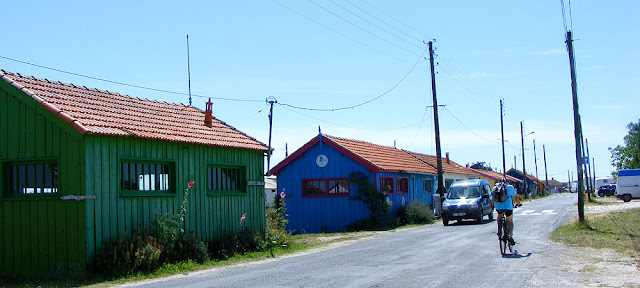 |
The western front of the church. The old wooden scaffolding slots have been filled with a sloping slate, presumably to discourage birds.
|
The church at La Celle Guenand has been in a sorry state for years, mainly due to serious damp issues. But now the first stage of a major restoration project has been completed, and it is saved. In parts it is beautiful, but in others, the damage is still all too obvious -- but at least now will not get worse.
 |
Detail of the western door surround.
|
Much of the fabulous original detail of the church has been lost to weathering, overpainting or plastering, or the slow action of water seeping through, indicated by algal growth. Disasterously, a concrete render had been used on the inside, and has now been chipped away to allow the stones to 'breathe'.
 |
The remnants of the northern transepts original apsoidal end.
|
An idea of what the church once looked like can be obtained by going to our friends at Loire Valley Eperience. They visited in 2013 and posted photos on their blog. [Church on Sunday...La Celle Guenand]
 |
An interesting looking capital on the exterior. I can't quite make out the subject.
|
The church, consisting at the time of a single nave, western door and bell tower, was built in the 12th century, then enlarged in the 15th century with a choir, and again in the 16th century when a seigniorial chapel replaced the southern apse. It was restored in the 19th century ( I would guess this is when the concrete on the interior walls was applied).
 |
The eastern end.
|
In the 12th century the church, built on the plan of a Latin cross, consisted of a single nave, a transept with crossings and absidioles (small apses), and a choir terminated by a an apse. In the 13th century the nave was vaulted and divided into a nave and two side aisles.
 |
The Remillon River at the back of the church.
|
The damp walls of the nave are topped by a moulded cornice in the form of a line of chevrons. The walls are pierced by three unequal round arched windows. The most decorative is the first on the north side, with an arch which meets two small columns. A round arched lateral door opens on the south side, in the middle of solid masonry protruding from the wall. A forecourt with a staircase to the roofspace was added on the same side in the 13th century, when the vaulting was done. There are traces of a filled in doorway on the north side.
 |
The oval cupola.
|
The original nave was in wood, later becoming a stone vaulted construction divided into nave and two side aisles, all with unequal spans. Three pointed arches connect the nave to the side aisles. The supports are solid piles, square on three faces, forming the backs for attached columns to support the arcades and cupolas. The capitals of the first archway are cubicular. The second and third have capitals decorated with foliage and volutes.
The first span of the nave was redone in the 15th century, keeping the original shape but with prominent moulded ribs. The second span kept its 13th century vault, with ribs of a different profile. The third vault is an unusual kidney shaped oval cupola.
The two side aisles are covered by short sided barrel vaults, resting on the piles and supporting the outer walls, with narrow crosswise pointed arches. The first barrel vault on the south supports a staircase to the roofspace and is reinforced on the west by a column decorated with a carved human head.
A short barrel vaulted bay connects the nave to the transept crossing, bounded by four semicircular arches from columns which are topped by openwork capitals with chamfered edges adorned with balls or foliage. The crossing is covered by an eight sided cupola. The transepts themselves have barrel vaulted ceilings done in the 19th century. A blind arcade adorns the south and west walls of the southern transept. The transepts were originally apsoidal ended, but the only remnant is part of the northern one.
The choir is rectangular, with pointed arches and illuminated on the north by a lancet window and on the east by another window. Next to it on the southern side is the seigniorial chapel dating from the 16th century. This chapel is now the sacristy. The arches are pointed. The space is lit by a Flamboyant Gothic window on the east and a simple bay with no mullion on the south.






















































